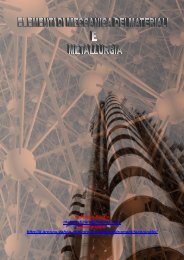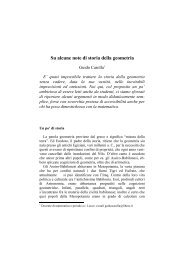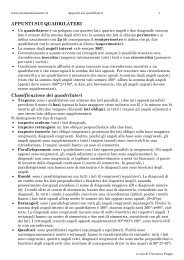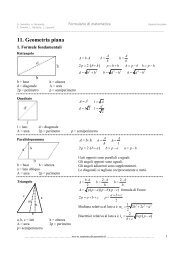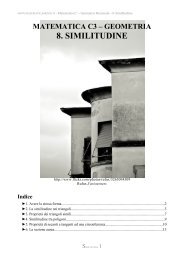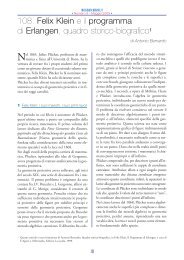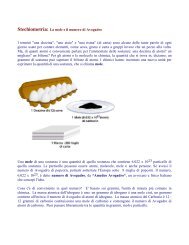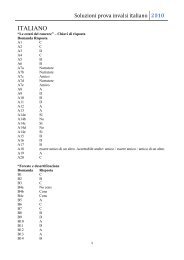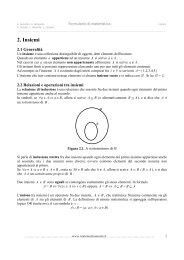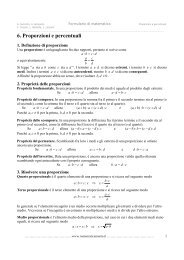Scarica la tesi Integrale di Feynman sui Cammini e Processi Stocastici
Scarica la tesi Integrale di Feynman sui Cammini e Processi Stocastici
Scarica la tesi Integrale di Feynman sui Cammini e Processi Stocastici
Create successful ePaper yourself
Turn your PDF publications into a flip-book with our unique Google optimized e-Paper software.
Sapendo che ( xj+1−xj<br />
ɛ<br />
S[x(·)] t′′<br />
t ′ =<br />
) 2 = ( x(tj+1)−x(tj)<br />
ɛ ) 2 e che l’azione c<strong>la</strong>ssica è<br />
t ′′<br />
t ′<br />
dt<br />
<br />
1<br />
2 m ˙x(t)2 <br />
− V (x(t))<br />
(12)<br />
allora è facile vedere che il termine ɛ [...] dell’eq.(11), ad N fissato, è proprio<br />
tale azione c<strong>la</strong>ssica calco<strong>la</strong>ta lungo <strong>la</strong> spezzata ΓN.<br />
Nel limite limN→+∞, <strong>la</strong> spezzata ΓN <strong>di</strong>venta una curva continua x(t) con<br />
stessi estremi fissi. L’insieme CN (x ′ , t ′ ; x ′′ , t ′′ ) <strong>di</strong>venta lo spazio dei cammini<br />
C(x ′ , t ′ ; x ′′ , t ′′ ), cioè l’insieme delle funzioni reali continue x(t) con estremi<br />
x(t ′ ) = x ′ , x(t ′′ ) = x ′′ . L’eq.(11) può dunque essere riscritta in maniera poco<br />
rigorosa:<br />
〈x ′′ , t ′′ |x ′ , t ′ 〉 =<br />
<br />
<br />
m<br />
Dx(t) = lim<br />
N→+∞ 2πi¯hɛ<br />
C<br />
Dx(t) · exp{(i/¯h)S[x(·)] t′′<br />
t ′ } (13)<br />
N/2 N−1 <br />
i=1<br />
dx(ti)<br />
Nell’eq.(13) si vede che per N → ∞ il termine Dx(t) è <strong>di</strong>vergente, mentre il<br />
temine exp{(i/¯h)S[x(·)] t′′<br />
t ′ }, oscil<strong>la</strong>ndo rapidamente, tende ad eliminare questa<br />
<strong>di</strong>vergenza facendo si che nell’espressione (11) il limite esiste. Tuttavia, come<br />
sarà mostrato nel<strong>la</strong> sezione 0.7, il prodotto <strong>di</strong> questi due fattori non è in grado<br />
<strong>di</strong> definire una misura per l’integrale funzionale. Quin<strong>di</strong> si ha che l’espressione<br />
(13) non è matematicamente corretta. Per il momento però trascuriamo questo<br />
aspetto e ci concentriamo sul significato fisico <strong>di</strong> questo risultato, che verrà<br />
espresso nel<strong>la</strong> prossima sezione.<br />
0.3 Formu<strong>la</strong>zione <strong>di</strong> <strong>Feynman</strong> del<strong>la</strong> Meccanica<br />
Quantistica: Postu<strong>la</strong>ti.<br />
Consideriamo una particel<strong>la</strong> S descritta dall’azione c<strong>la</strong>ssica (12) e fissiamo l’attenzione<br />
sull’evento A: S va da (x ′ , t ′ ) a (x ′′ , t ′′ ). L’ampiezza 〈x ′′ , t ′′ |x ′ , t ′ 〉 associata<br />
a questo evento è il propagatore dell’equazione <strong>di</strong> Schrö<strong>di</strong>nger nelle varibili<br />
(x ′′ , t ′′ ).<br />
Postu<strong>la</strong>to 1 Tutte le alternative <strong>di</strong>sgiunte (cioè in<strong>di</strong>pendenti mutuamente esclusive)<br />
secondo le quali l’evento A può realizzarsi sono descritte da cammini<br />
x(t) ∈ C(x ′ , t ′ ; x ′′ , t ′′ ).<br />
L’idea fondamentale <strong>di</strong> <strong>Feynman</strong> è <strong>di</strong> associare un’ampiezza <strong>di</strong> probabilità ad<br />
ogni alternativa <strong>di</strong>sgiunta re<strong>la</strong>tiva all’evento A in questione. Nel<strong>la</strong> formu<strong>la</strong>zione<br />
standard si associa invece un’ampiezza <strong>di</strong> probabilità, ψ(x, t), al<strong>la</strong> posizione <strong>di</strong><br />
una particel<strong>la</strong> ad un partico<strong>la</strong>re istante.<br />
Esprimiamo l’ampiezza che S si muova lungo x(t) con 〈x ′′ , t ′′ |x ′ , t ′ 〉[x(·)].<br />
Postu<strong>la</strong>to 2 I cammini x(t) ∈ C(x ′ , t ′ ; x ′′ , t ′′ ) contribuiscono ugualmente in<br />
modulo, ma <strong>la</strong> fase dei loro contributi è data dall’azione c<strong>la</strong>ssica (in unità <strong>di</strong> ¯h),<br />
cioè dall’integrale temporale del<strong>la</strong> <strong>la</strong>grangiana calco<strong>la</strong>to lungo il cammino.<br />
〈x ′′ , t ′′ |x ′ , t ′ 〉[x(·)] = exp{(i/¯h)S[x(·)] t′′<br />
t ′ }<br />
4



